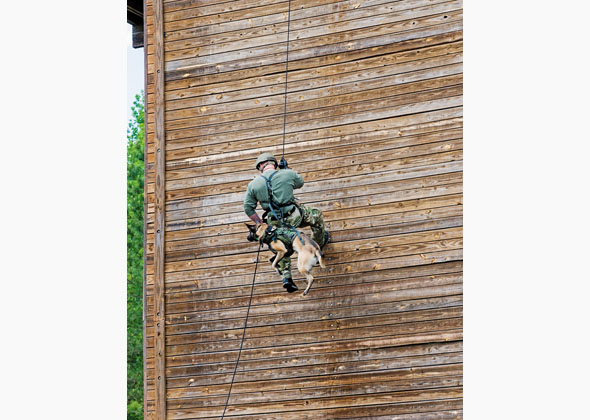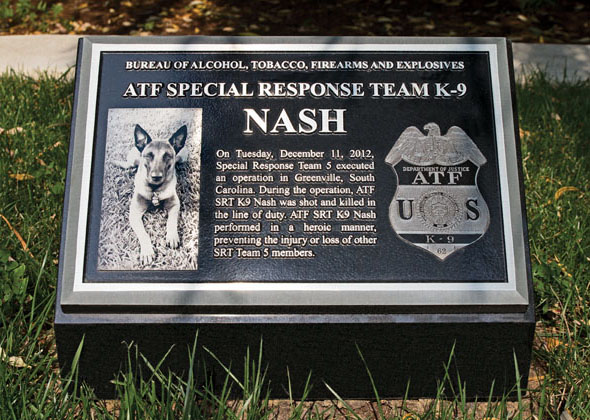Honoring the Canine Heroes of the ATF
by Blaine Novak
Published on January 07, 2015
Skip To

ATF SRT canines work with their handlers in a variety of fashions, including working with tactical teams to clear buildings and other target locations in search of violent criminals, performing searches for hidden suspects, conducting tracking and large area search missions, and, as a last resort, attacking violent criminals who pose a threat to the public. One of the benefits of deploying with a canine, says Jeffrey Perryman, the Special Response Team Canine Program Manager/Handler, is the dog’s ability to use its senses — the dog’s sense of smell, hearing, and overall instincts — to locate or apprehend criminals, which Perryman says in turn enhances safety for the agents and the public. Here are some of the amazing canines and handlers who protect us every day.
A Canine Program Is Born: Boomer and Jeff Perryman
In 2000, the agency tested a pilot program whereby an ATF special agent would train with a canine. This canine team would then be attached to SRT 1, which covered 14 states in the Midwest, and assist in the mission to fight violent crime across the country. ATF was the first organization within the Department of Justice to have a full-time handler and canine attached to a federal team.Special Agent Jeffrey Perryman was selected as the first handler, and was paired with his first canine partner — a remarkable dog named Boomer. Perryman and Boomer were trained by two very talented K9 law enforcement officers named Terry and Diane Shoenbach. Over the years, Perryman and his dogs have also trained at the K9 Advanced Training Facility in Taylor, Michigan, and Cher Car Kennels in St. Johns, Michigan. In their first year together, Perryman and Boomer were involved in numerous operations, but two in particular highlighted the unique talents of an ATF handler working in harmony with a canine partner. The first example was a case where a suspect who’d seriously assaulted an individual in Lincoln, Nebraska, was reported to be holed up in a house. After a thorough search, human agents found one individual but found no sign of the primary suspect. So Perryman requested to let Boomer search the house. Perryman thought it would be a good piece of training for Boomer to search a structure he’d never seen.
“We let Boomer search and he ends up getting into this walk-in attic. We all looked in there and it appears to be totally empty. There’s nothing in there. All of the sudden Boomer is just ripping into the insulation. I’m looking at him wondering what he’s doing. In the law enforcement canine community there is an old adage that says you should always trust your dog. As a new handler, I didn’t fully grasp that concept just yet,” Perryman says.

Boomer’s find was a great circumstance, because once the SRT departs the house, a group of agents are assigned to come in and search the premises. If Boomer hadn’t found this known violent criminal, there very likely would have been a serious confrontation between the suspect and the follow-up agents once they started the search for evidence. Boomer potentially saved their lives, as well as, ironically, the suspect’s life. “Luckily Boomer was there and we found him. That was the first time executives in Washington, D.C., started hearing about what he could do,” Perryman says.
The second big break for the ATF SRT canine program occurred a few months later in Pensacola, Florida. The ATF was working with Customs, DEA, and local law enforcement to hit a large compound where illegal methamphetamines were being produced. It was a massive operation spread across several acres of land, which included a barn, a house, and about 40 junked cars.
The agents and officers converged on the property and took five people into custody. Once the property was secure, one of the forward observers, or snipers, notified the SRT Team Leader, Special Agent Don Brougher, that he had observed an individual in a dark sweatshirt fleeing one of the buildings, and that this individual was not currently in custody. So Perryman requested through Special Agent Brougher to take Boomer around the property to see if the canine would catch the scent of anyone who might have left the property.

Boomer shot straight for the rusty junk cars with the flat tires and began circling a full-size van. The tires were blown, and grass had grown up around it.
“I didn’t see a thing under there,” Perryman says. “Again I thought, ‘OK, I’ll play along,’ so I call Boomer back and I say, ‘You under that van, come out.’ And I see this guy lower himself. He had pulled himself into the lower frame of the van. So if you look under it you can’t see him. So he lowers himself and comes out and he was the guy who fled the scene, dark sweatshirt. After this operation, people in Washington became true believers in these talented dogs.”
Nash and Jeff Kunz: Partners and Friends
Nash, a Belgian Malinois, was part of the family from the moment he was presented as a potential ATF SRT canine partner for Special Agent Jeff Kunz. “My wife and son actually picked him out,” Kunz says. “The vendor, Ivan Balabanov, brought two dogs out, Nosco and Nash. I actually liked Nosco, but my wife and son were with Nash, looking at him. And Nash would bring a toy right to my son.”Kunz was impressed, and he took Nash home. While Kunz underwent a knee surgery, Nash bonded with Kunz’ wife. “From that time on, he was basically part of my family. You know, a working dog but he’s also a family pet,” Kunz says.
Kunz and Nash bonded as partners, too. They had deployed on over 200 high-risk operations together. On Dec. 11, 2012, Kunz and Nash were on assignment in the process of arresting a very violent home invasion robbery crew. Kunz and Nash were part of the arrest team in a hidden location.
“So the plan was, if the suspects did run, Nash would stop and apprehend them,” Kunz says.
On the signal, Kunz and Nash came out, proceeded to their hard right, and saw four suspects running. But two were running right up the middle aisle.
When Nash saw the fleeing suspects, he began pulling. Kunz called for the suspects to stop, but they didn’t stop. So Kunz released Nash. Then the unthinkable happened. One of the suspects took a hard left and pulled out a gun and began shooting at a group of SRT agents who were blocking his path.
When the suspect saw Nash coming at him, he stopped shooting at the agents and targeted his gun and his gunfire towards Nash. “And then he shot Nash and then he shot a couple rounds toward us,” Kunz says. “At that time, myself and two other guys shot at him, and the suspect dove to the ground and surrendered. But Nash obviously diverted his attention. One of our medics was in the line of fire driving the blocking vehicle. He was getting shot at and he said the rounds were coming closer and closer to him until Nash got the guy’s attention.”
Nash’s actions likely saved lives that day — and his heroics cost him his own.
“Some people think I sent him after the guy who was shooting. That’s not our policy,” Kunz says. “It’s not my policy as a handler to send him after somebody who’s shooting at us. The suspect I sent him at was unarmed, fleeing from us. Nash acted to protect us on his own.”
Nash’s instinct to protect his team of human agents may have been a result of the team-building activities the canines and their handlers engage in together, it may have been his canine pack instincts, or it may have been a combination of both. Kunz was devastated that the suspect pulled out a gun and started firing before he could call Nash back.
When Nash died in the line of duty, Kunz knew he couldn’t tell his family, at home in south Florida, over the phone. So his supervisor put him on a plane for home immediately.
“My wife was devastated, my son was devastated. It took — I can’t even say they’re over it yet. The dog was basically a family pet, a working dog, and he left and didn’t come back. They didn’t get a chance to say goodbye.”
In the time since Nash’s act of heroism, Kunz has been partnered with a new canine officer, Jager. Jager is becoming part of the family, Kunz says, and they’re taking time to integrate him properly with their other canine family member, a Golden Retriever.
Nash was memorialized with a plaque in ATF’s D.C. headquarters courtyard, and will be memorialized further with a life-sized replica statue that will be placed in the new auditorium and conference hall at the Federal Law Enforcement Training Center (FLETC) in Brunswick, Georgia.
Part of the Family
While the dogs are owned by the government, they live — and stay in the house — with their handlers. “When these canines retire, we do whatever is best for the dog. If that means retiring to the handler’s family, that’s exactly what we do. We want this hero to know they will always be cared for, and a member of the family,” Perryman says.Including Ike, there are nine canine teams spread across the country in ATF’s tactical canine program. The agents behind the dogs are heroes in their own right. Thomas Brandon, the Deputy Director for the ATF, is passionate about the brotherhood that exists amongst this group of humble public servants who work diligently to protect and serve. These are the best of the best law enforcement agents working to fight the worst of the worst criminals.
Brandon says, “There’s a quote from Winston Churchill — and I really believe this — ‘You make a living by what you get, but you make a life by what you give.’ I’ve been privileged to be put in this position. I’ve been trying to give back, to help focus on our mission. And if you can help people along the way, sometimes that’s what money can’t buy.”
This article originally appeared in the winter issue of HealthyPet Magazine.









